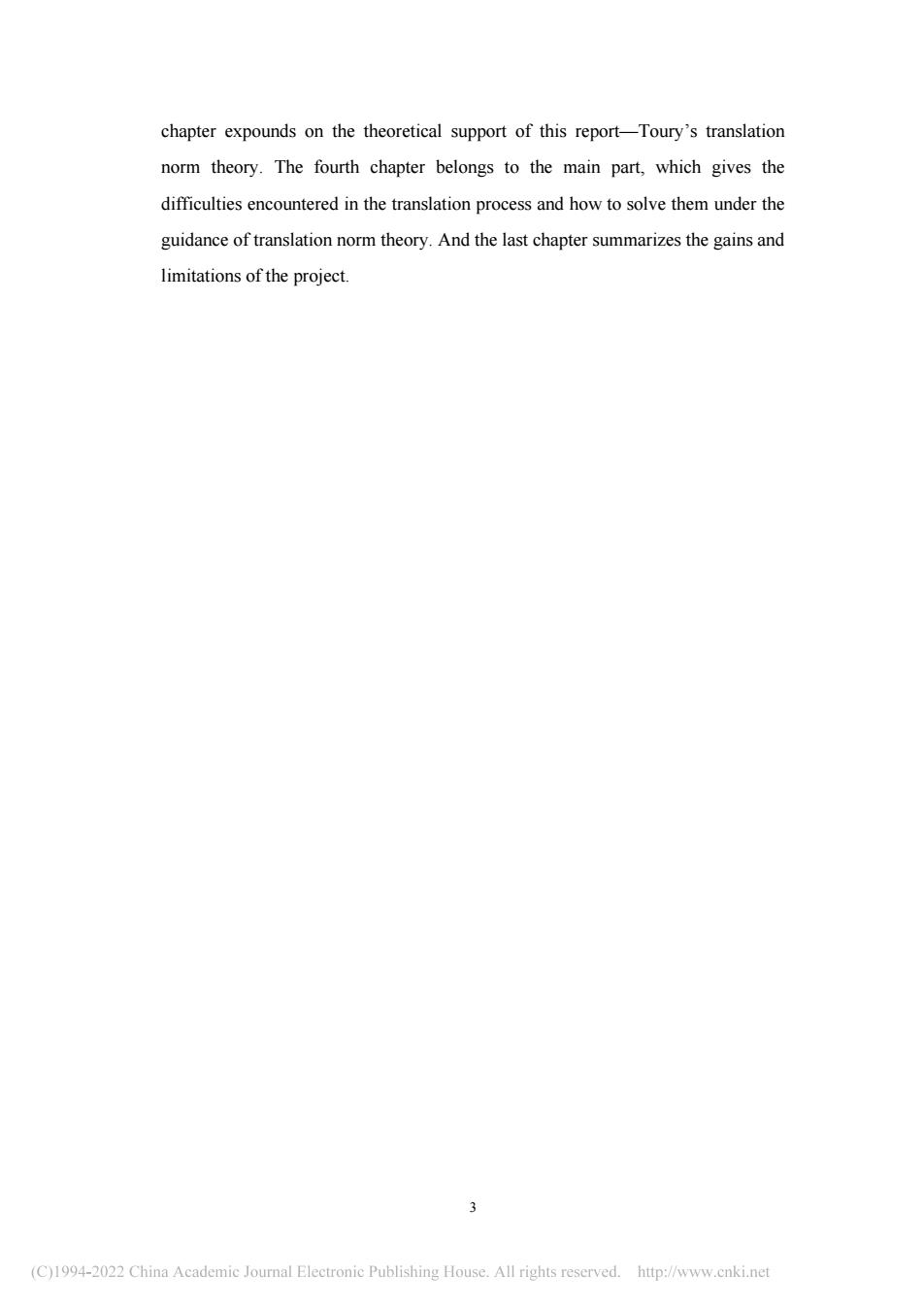
chapter expounds on the theoretical support of this report-Toury's translation norm theory.The fourth chapter belongs to the main part,which gives the difficulties encountered in the translation process and how to solve them under the guidance of translation norm theory.And the last chapter summarizes the gains and limitations of the project. 3 (C)1994-022 China Academie Joumal Electronic Publishing House.All rights reserved.http://www.cnki.net
3 chapter expounds on the theoretical support of this report—Toury’s translation norm theory. The fourth chapter belongs to the main part, which gives the difficulties encountered in the translation process and how to solve them under the guidance of translation norm theory. And the last chapter summarizes the gains and limitations of the project
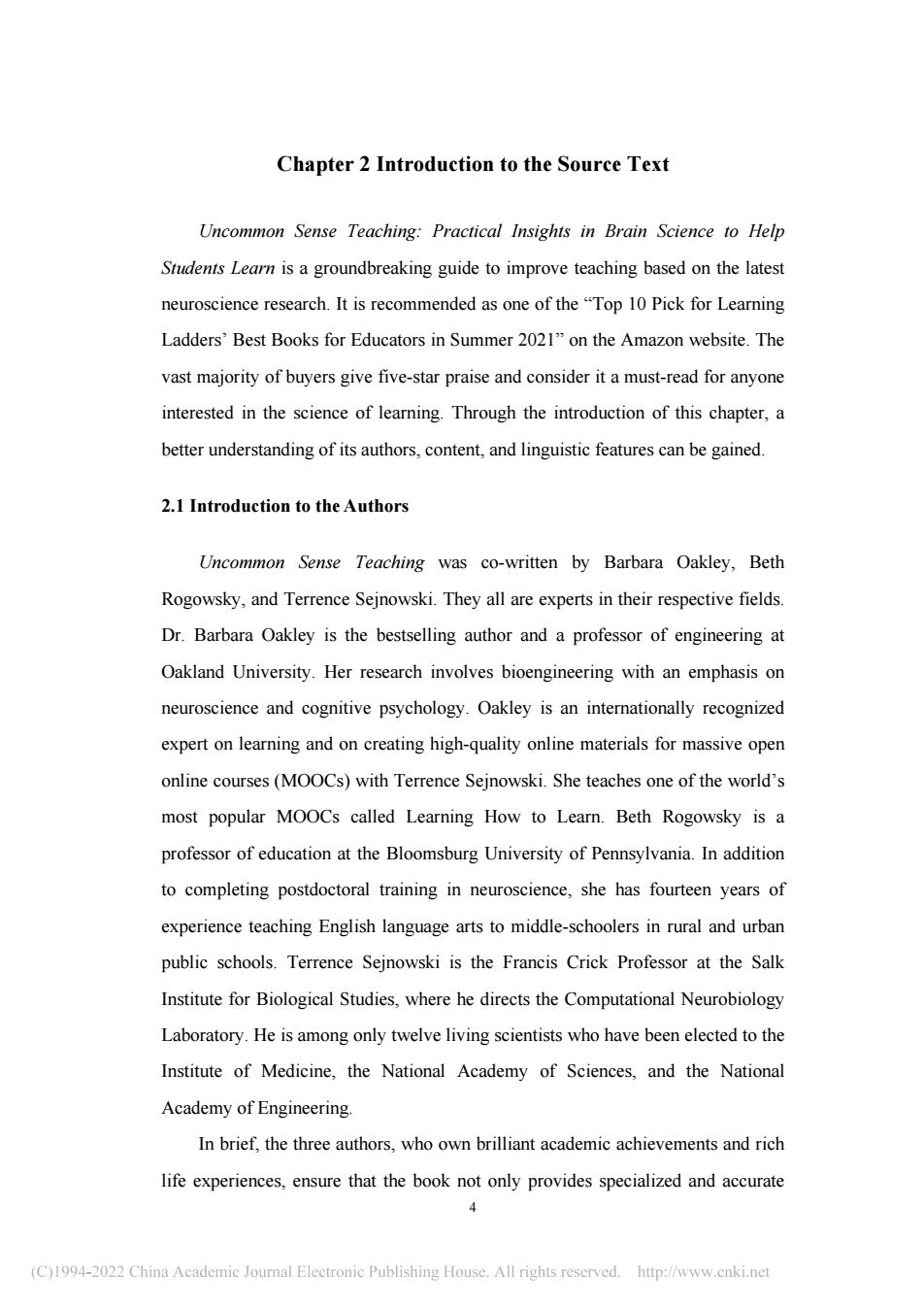
Chapter 2 Introduction to the Source Text Uncommon Sense Teaching:Practical Insights in Brain Science to Help Siudents Learn is a groundbreaking guide to improve teaching based on the latest neuroscience research.It is recommended as one of the"Top 10 Pick for Learning Ladders'Best Books for Educators in Summer 2021"on the Amazon website.The vast majority of buyers give five-star praise and consider it a must-read for anyone interested in the science of learning.Through the introduction of this chapter,a better understanding of its authors,content,and linguistic features can be gained. 2.1 Introduction to the Authors Uncommon Sense Teaching was co-written by Barbara Oakley,Beth Rogowsky,and Terrence Sejnowski.They all are experts in their respective fields. Dr.Barbara Oakley is the bestselling author and a professor of engineering at Oakland University.Her research involves bioengineering with an emphasis on neuroscience and cognitive psychology.Oakley is an internationally recognized expert on learning and on creating high-quality online materials for massive open online courses(MOOCs)with Terrence Sejnowski.She teaches one of the world's most popular MOOCs called Learning How to Learn.Beth Rogowsky is a professor of education at the Bloomsburg University of Pennsylvania.In addition to completing postdoctoral training in neuroscience,she has fourteen years of experience teaching English language arts to middle-schoolers in rural and urban public schools.Terrence Sejnowski is the Francis Crick Professor at the Salk Institute for Biological Studies,where he directs the Computational Neurobiology Laboratory.He is among only twelve living scientists who have been elected to the Institute of Medicine,the National Academy of Sciences,and the National Academy of Engineering. In brief,the three authors,who own brilliant academic achievements and rich life experiences,ensure that the book not only provides specialized and accurate (C)1994-2022 China Academie Joural Electronie Publishing House.All rights reserved.http://www.enki.net
4 Chapter 2 Introduction to the Source Text Uncommon Sense Teaching: Practical Insights in Brain Science to Help Students Learn is a groundbreaking guide to improve teaching based on the latest neuroscience research. It is recommended as one of the “Top 10 Pick for Learning Ladders’ Best Books for Educators in Summer 2021” on the Amazon website. The vast majority of buyers give five-star praise and consider it a must-read for anyone interested in the science of learning. Through the introduction of this chapter, a better understanding of its authors, content, and linguistic features can be gained. 2.1 Introduction to the Authors Uncommon Sense Teaching was co-written by Barbara Oakley, Beth Rogowsky, and Terrence Sejnowski. They all are experts in their respective fields. Dr. Barbara Oakley is the bestselling author and a professor of engineering at Oakland University. Her research involves bioengineering with an emphasis on neuroscience and cognitive psychology. Oakley is an internationally recognized expert on learning and on creating high-quality online materials for massive open online courses (MOOCs) with Terrence Sejnowski. She teaches one of the world’s most popular MOOCs called Learning How to Learn. Beth Rogowsky is a professor of education at the Bloomsburg University of Pennsylvania. In addition to completing postdoctoral training in neuroscience, she has fourteen years of experience teaching English language arts to middle-schoolers in rural and urban public schools. Terrence Sejnowski is the Francis Crick Professor at the Salk Institute for Biological Studies, where he directs the Computational Neurobiology Laboratory. He is among only twelve living scientists who have been elected to the Institute of Medicine, the National Academy of Sciences, and the National Academy of Engineering. In brief, the three authors, who own brilliant academic achievements and rich life experiences, ensure that the book not only provides specialized and accurate
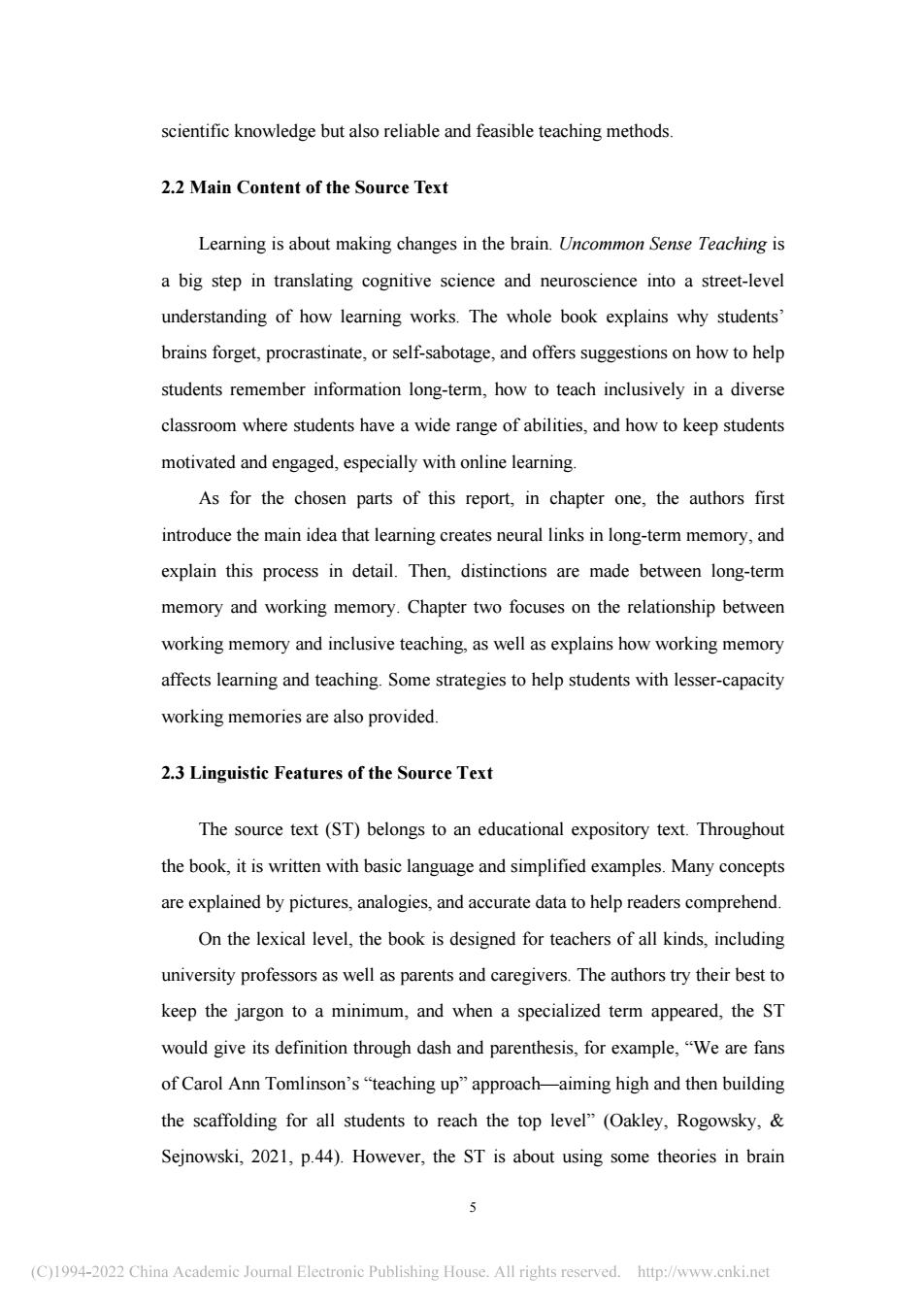
scientific knowledge but also reliable and feasible teaching methods. 2.2 Main Content of the Source Text Learning is about making changes in the brain.Uncommon Sense Teaching is a big step in translating cognitive science and neuroscience into a street-level understanding of how learning works.The whole book explains why students brains forget,procrastinate,or self-sabotage,and offers suggestions on how to help students remember information long-term,how to teach inclusively in a diverse classroom where students have a wide range of abilities,and how to keep students motivated and engaged,especially with online learning. As for the chosen parts of this report,in chapter one,the authors first introduce the main idea that learning creates neural links in long-term memory,and explain this process in detail.Then,distinctions are made between long-term memory and working memory.Chapter two focuses on the relationship between working memory and inclusive teaching,as well as explains how working memory affects learning and teaching.Some strategies to help students with lesser-capacity working memories are also provided. 2.3 Linguistic Features of the Source Text The source text(ST)belongs to an educational expository text.Throughout the book,it is written with basic language and simplified examples.Many concepts are explained by pictures,analogies,and accurate data to help readers comprehend. On the lexical level,the book is designed for teachers of all kinds,including university professors as well as parents and caregivers.The authors try their best to keep the jargon to a minimum,and when a specialized term appeared,the ST would give its definition through dash and parenthesis,for example,We are fans of Carol Ann Tomlinson's"teaching up"approach-aiming high and then building the scaffolding for all students to reach the top level"(Oakley,Rogowsky,& Sejnowski,2021,p.44).However,the ST is about using some theories in brain (C)1994-2022 China Academie Joumal Electronie Publishing House.All rights reserved.http://www.enki.net
5 scientific knowledge but also reliable and feasible teaching methods. 2.2 Main Content of the Source Text Learning is about making changes in the brain. Uncommon Sense Teaching is a big step in translating cognitive science and neuroscience into a street-level understanding of how learning works. The whole book explains why students’ brains forget, procrastinate, or self-sabotage, and offers suggestions on how to help students remember information long-term, how to teach inclusively in a diverse classroom where students have a wide range of abilities, and how to keep students motivated and engaged, especially with online learning. As for the chosen parts of this report, in chapter one, the authors first introduce the main idea that learning creates neural links in long-term memory, and explain this process in detail. Then, distinctions are made between long-term memory and working memory. Chapter two focuses on the relationship between working memory and inclusive teaching, as well as explains how working memory affects learning and teaching. Some strategies to help students with lesser-capacity working memories are also provided. 2.3 Linguistic Features of the Source Text The source text (ST) belongs to an educational expository text. Throughout the book, it is written with basic language and simplified examples. Many concepts are explained by pictures, analogies, and accurate data to help readers comprehend. On the lexical level, the book is designed for teachers of all kinds, including university professors as well as parents and caregivers. The authors try their best to keep the jargon to a minimum, and when a specialized term appeared, the ST would give its definition through dash and parenthesis, for example, “We are fans of Carol Ann Tomlinson’s “teaching up” approach—aiming high and then building the scaffolding for all students to reach the top level” (Oakley, Rogowsky, & Sejnowski, 2021, p.44). However, the ST is about using some theories in brain
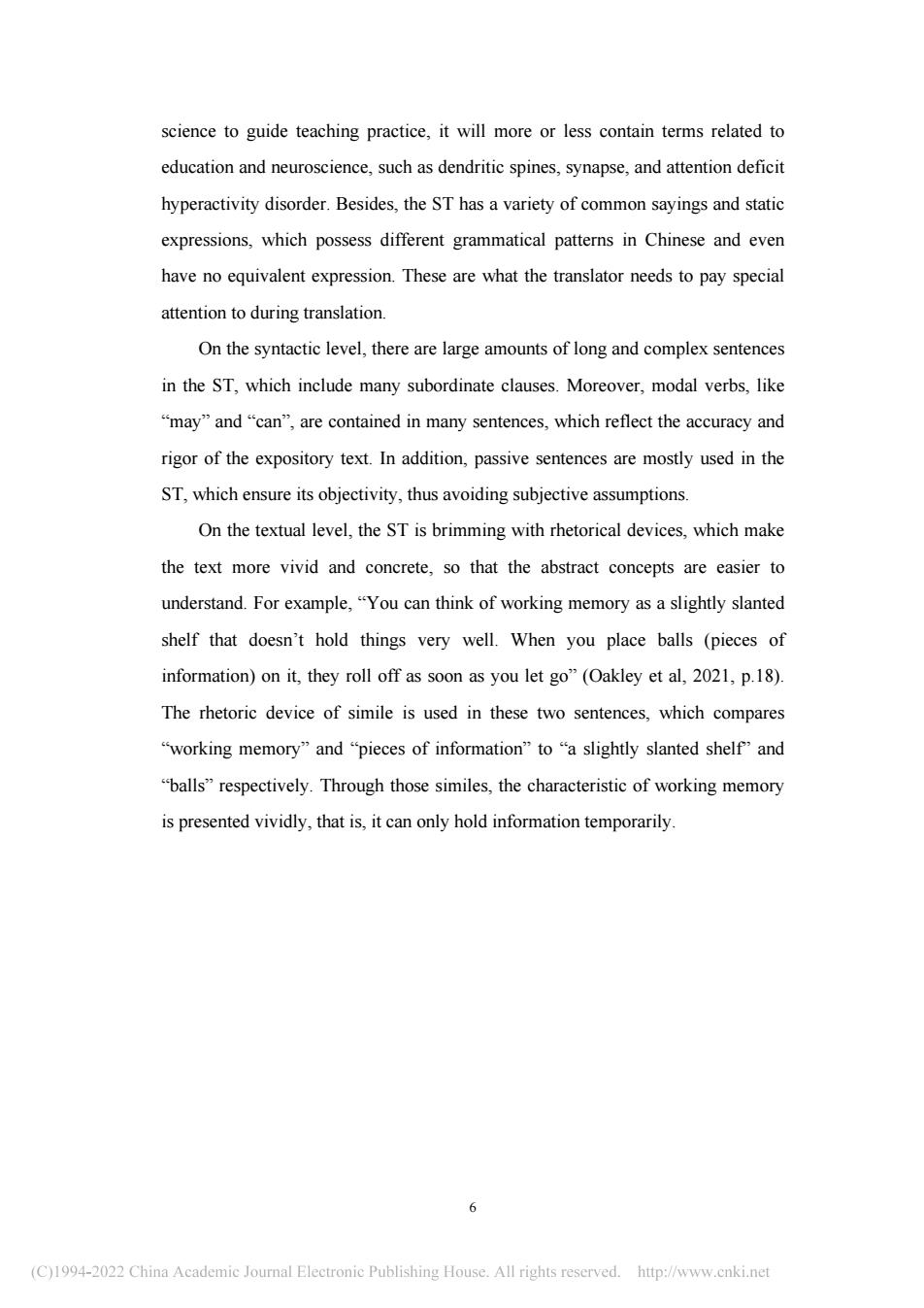
science to guide teaching practice,it will more or less contain terms related to education and neuroscience,such as dendritic spines,synapse,and attention deficit hyperactivity disorder.Besides,the SThas a variety of common sayings and static expressions,which possess different grammatical patterns in Chinese and even have no equivalent expression.These are what the translator needs to pay special attention to during translation. On the syntactic level,there are large amounts of long and complex sentences in the ST,which include many subordinate clauses.Moreover,modal verbs,like “may”and“can”,are contained in many sentences,.which reflect the accuracy and rigor of the expository text.In addition,passive sentences are mostly used in the ST.which ensure its objectivity,thus avoiding subjective assumptions On the textual level,the STis brimming with rhetorical devices,which make the text more vivid and concrete,so that the abstract concepts are easier to understand.For example,"You can think of working memory as a slightly slanted shelf that doesn't hold things very well.When you place balls (pieces of information)on it,they roll off as soon as you let go"(Oakley et al,2021,p.18). The rhetoric device of simile is used in these two sentences,which compares "working memory"and "pieces of information"to"a slightly slanted shelf"and balls"respectively.Through those similes,the characteristic of working memory is presented vividly,that is,it can only hold information temporarily. 6 (C)1994-2022 China Academie Joumal Electronie Publishing House.All rights reserved.http://www.enki.net
6 science to guide teaching practice, it will more or less contain terms related to education and neuroscience, such as dendritic spines, synapse, and attention deficit hyperactivity disorder. Besides, the ST has a variety of common sayings and static expressions, which possess different grammatical patterns in Chinese and even have no equivalent expression. These are what the translator needs to pay special attention to during translation. On the syntactic level, there are large amounts of long and complex sentences in the ST, which include many subordinate clauses. Moreover, modal verbs, like “may” and “can”, are contained in many sentences, which reflect the accuracy and rigor of the expository text. In addition, passive sentences are mostly used in the ST, which ensure its objectivity, thus avoiding subjective assumptions. On the textual level, the ST is brimming with rhetorical devices, which make the text more vivid and concrete, so that the abstract concepts are easier to understand. For example, “You can think of working memory as a slightly slanted shelf that doesn’t hold things very well. When you place balls (pieces of information) on it, they roll off as soon as you let go” (Oakley et al, 2021, p.18). The rhetoric device of simile is used in these two sentences, which compares “working memory” and “pieces of information” to “a slightly slanted shelf” and “balls” respectively. Through those similes, the characteristic of working memory is presented vividly, that is, it can only hold information temporarily
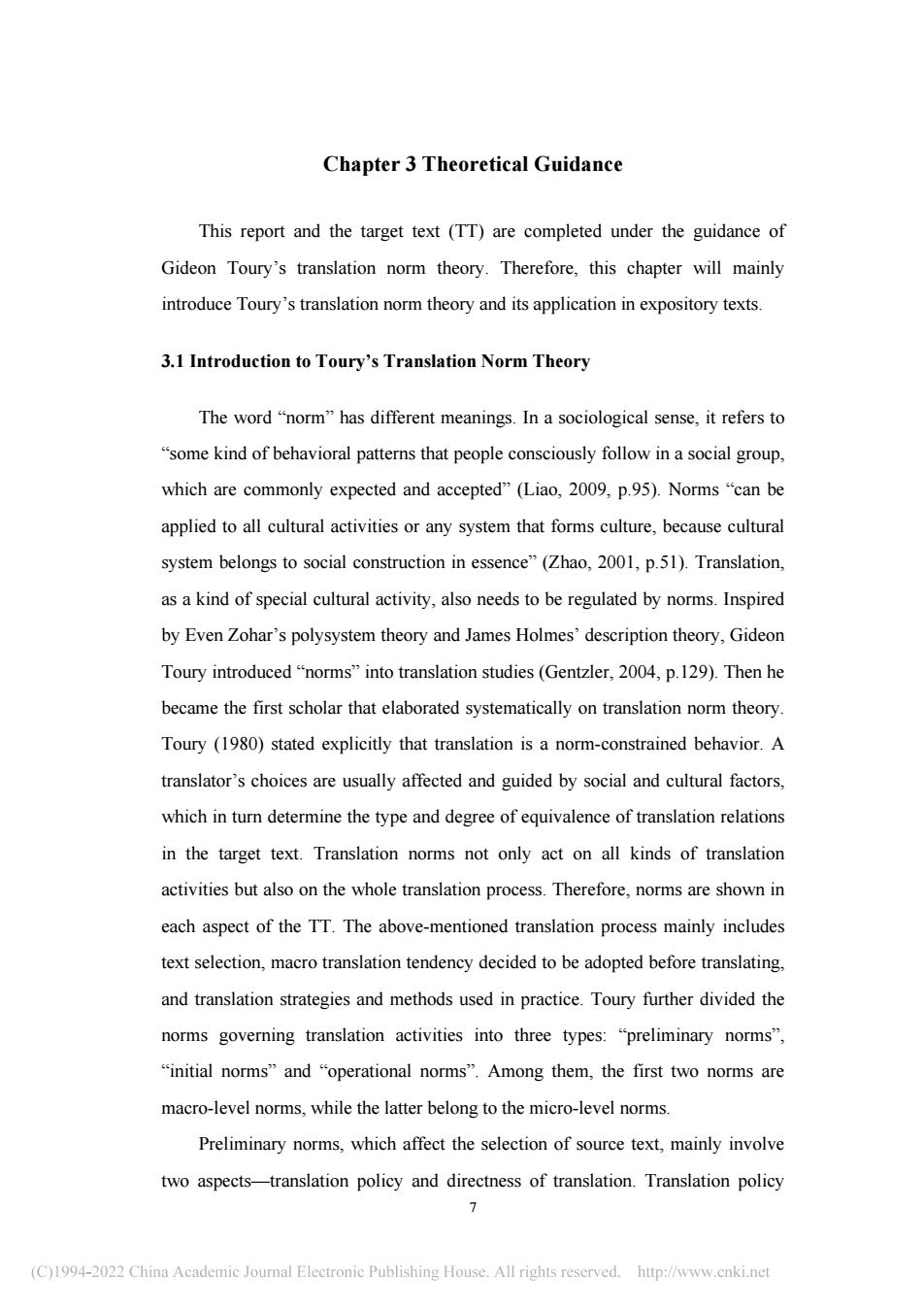
Chapter 3 Theoretical Guidance This report and the target text (TT)are completed under the guidance of Gideon Toury's translation norm theory.Therefore,this chapter will mainly introduce Toury's translation norm theory and its application in expository texts. 3.1 Introduction to Toury's Translation Norm Theory The word"norm"has different meanings.In a sociological sense,it refers to "some kind of behavioral patterns that people consciously follow in a social group, which are commonly expected and accepted"(Liao,2009,p.95).Norms"can be applied to all cultural activities or any system that forms culture,because cultura system belongs to social construction in essence"(Zhao,2001,p.51).Translation, as a kind of special cultural activity,also needs to be regulated by norms.Inspired by Even Zohar's polysystem theory and James Holmes'description theory,Gideon Toury introduced"norms"into translation studies(Gentzler,2004,p.129).Then he became the first scholar that elaborated systematically on translation norm theory. Toury (1980)stated explicitly that translation is a norm-constrained behavior.A translator's choices are usually affected and guided by social and cultural factors which in turn determine the type and degree of equivalence of translation relations in the target text.Translation norms not only act on all kinds of translation activities but also on the whole translation process.Therefore,norms are shown in each aspect of the TT.The above-mentioned translation process mainly includes text selection,macro translation tendency decided to be adopted before translating. and translation strategies and methods used in practice.Toury further divided the norms governing translation activities into three types:"preliminary norms" "initial norms"and "operational norms".Among them,the first two norms are macro-level norms,while the latter belong to the micro-level norms. Preliminary norms,which affect the selection of source text,mainly involve two aspects-translation policy and directness of translation.Translation policy (C)1994-2022 China Academie Joumal Electronie Publishing House.All rights reserved.http://www.enki.net
7 Chapter 3 Theoretical Guidance This report and the target text (TT) are completed under the guidance of Gideon Toury’s translation norm theory. Therefore, this chapter will mainly introduce Toury’s translation norm theory and its application in expository texts. 3.1 Introduction to Toury’s Translation Norm Theory The word “norm” has different meanings. In a sociological sense, it refers to “some kind of behavioral patterns that people consciously follow in a social group, which are commonly expected and accepted” (Liao, 2009, p.95). Norms “can be applied to all cultural activities or any system that forms culture, because cultural system belongs to social construction in essence” (Zhao, 2001, p.51). Translation, as a kind of special cultural activity, also needs to be regulated by norms. Inspired by Even Zohar’s polysystem theory and James Holmes’ description theory, Gideon Toury introduced “norms” into translation studies (Gentzler, 2004, p.129). Then he became the first scholar that elaborated systematically on translation norm theory. Toury (1980) stated explicitly that translation is a norm-constrained behavior. A translator’s choices are usually affected and guided by social and cultural factors, which in turn determine the type and degree of equivalence of translation relations in the target text. Translation norms not only act on all kinds of translation activities but also on the whole translation process. Therefore, norms are shown in each aspect of the TT. The above-mentioned translation process mainly includes text selection, macro translation tendency decided to be adopted before translating, and translation strategies and methods used in practice. Toury further divided the norms governing translation activities into three types: “preliminary norms”, “initial norms” and “operational norms”. Among them, the first two norms are macro-level norms, while the latter belong to the micro-level norms. Preliminary norms, which affect the selection of source text, mainly involve two aspects—translation policy and directness of translation. Translation policy